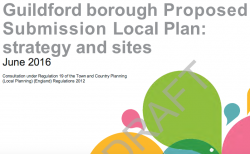 Abraham Lincoln
If given the truth, the people can be depended upon to meet any national crisis...
Abraham Lincoln
If given the truth, the people can be depended upon to meet any national crisis...
 Guildford news...
for Guildford people, brought to you by Guildford reporters - Guildford's own news service
Guildford news...
for Guildford people, brought to you by Guildford reporters - Guildford's own news service
Letter: More Housing Is Essential To Maintain Our High Standard of Living
Published on: 1 Jun, 2016
Updated on: 1 Jun, 2016
Hon Alderman and former Mayor of Guildford
Cllr Spooner is rightly concerned about the needs of future generations who will no longer be able to afford to live in Guildford, due mainly due to high housing costs largely resulting from land costs – around 75% of house prices are due to land.
We have been fortunate in meeting part of our labour need with immigrant labour who have institutional accommodation or live in substandard housing.
This cannot go on as our schools, hospital and of course our high tech enterprises which have transformed our economy and are and the country’s economic future are short of labour.
 It is not full appreciated by residents, councillors , and even planners that Guildford was classified as the “least disadvantaged community in Britain” in a government survey, and by a consultancy as the wealthiest (London apart), the second most dynamic (after Cambridge) and the second best educated (after Edinburgh). An incredible but unrecognised accolade.
It is not full appreciated by residents, councillors , and even planners that Guildford was classified as the “least disadvantaged community in Britain” in a government survey, and by a consultancy as the wealthiest (London apart), the second most dynamic (after Cambridge) and the second best educated (after Edinburgh). An incredible but unrecognised accolade.
Analysis of this extraordinary achievement needs to be carried out and figure in the revised draft plan (which it is not) for it will surely justify the need for housing young skilled workers who have been largely responsible for this achievement.
Finding enough housing and maintaining it as such presents formidable problems and while as much as possible should go in the town centre land costs here are high and housing is best used by elderly and single people.
To make provision in principle for family type housing on some small areas of the greenbelt (1.6%) seems sensible – though dependent on what housing numbers we have to accept. We must find ways of ensuring they meet the needs of young skilled workers and are well planned.
One can understand that most of us would prefer trees and birds as neighbours but surely we also need to consider the needs of the young ? Without a dynamic economy we cannot sustain the very high standard of living we have achieved into the future.
Responses to Letter: More Housing Is Essential To Maintain Our High Standard of Living
Leave a Comment Cancel replyPlease see our comments policy. All comments are moderated and may take time to appear.
Recent Articles
- Guildford Institute’s Crowdfunding Project for Accessible Toilet in its New Community and Wellbeing Centre
- Letter: Guildford – Another Opportunity Missed?
- Letter: GBC’s Corporate Strategy – Where Is the Ambition?
- My Memories of John Mayall at a Ground-breaking Gig in Guildford Nearly Six Decades Ago
- Westborough HMO Plans ‘Losing the Heart of the Street’ Says Resident
- College Invests to Boost Surrey’s Economy and Close Digital Skills Gap
- Community Lottery Brings Big Wins for Local Charities
- GBC Housing Plan Promises ‘A Vibrant Urban Neighbourhood’ Near Town Centre
- Hospital Pillows ‘Shortage’ at the Royal Surrey
- Updated: Caravans Set Up Camp at Ash Manor School


Recent Comments
- Ian Macpherson on Updated: Main Guildford to Godalming Road Closed Until August 1
- Sara Tokunaga on GBC Housing Plan Promises ‘A Vibrant Urban Neighbourhood’ Near Town Centre
- Michael Courtnage on Daily Mail Online Reports Guildford Has Highest-paid Council Officer
- Alan Judge on GBC Housing Plan Promises ‘A Vibrant Urban Neighbourhood’ Near Town Centre
- John Perkins on GBC Housing Plan Promises ‘A Vibrant Urban Neighbourhood’ Near Town Centre
- S Collins on GBC Housing Plan Promises ‘A Vibrant Urban Neighbourhood’ Near Town Centre
Search in Site
Media Gallery
Dragon Interview: Local Artist Leaves Her Mark At One of England’s Most Historic Buildings
January 21, 2023 / No Comment / Read MoreDragon Interview: Lib Dem Planning Chair: ‘Current Policy Doesn’t Work for Local People’
January 19, 2023 / No Comment / Read MoreA3 Tunnel in Guildford ‘Necessary’ for New Homes, Says Guildford’s MP
January 10, 2023 / No Comment / Read More‘Madness’ for London Road Scheme to Go Ahead Against ‘Huge Opposition’, Says SCC Leader
January 6, 2023 / No Comment / Read MoreCouncillor’s Son Starts Campaign for More Consultation on North Street Plan
December 30, 2022 / No Comment / Read MoreCounty Council Climbs Down Over London Road Works – Further ‘Engagement’ Period Announced
December 14, 2022 / No Comment / Read MoreDragon Interview: GBC Reaction to the Government’s Expected Decision to Relax Housing Targets
December 7, 2022 / No Comment / Read MoreHow Can Our Town Centre Businesses Recover? Watch the Shop Front Debate
May 18, 2020 / No Comment / Read More










Peter Shaw
June 1, 2016 at 8:18 pm
Its not 1.6%. If you include insetting of villages it will be around 6-7% of green belt that will be built upon.
Roland McKinney
June 2, 2016 at 12:15 am
Insetting is a policy designed to increase the number of houses built. See Policy D4 of the Local Plan. So insetting is about adding more houses – remember that 693 a year is a minimum. So the 6% lost to the green belt is all to do with housing.
Paul Spooner
June 2, 2016 at 6:30 am
In response to Mr Shaw insetting is because development already exists. Villages being inset have already been ‘built upon’ and are not open green belt in any shape or form.
Ben Paton
June 2, 2016 at 9:17 am
Perhaps Mr Bridger would care to adduce some facts in support of his untested assertions.
Mr Bridger wrote to The Dragon recently to say that only some 300 acres of Green Belt would be developed in the Local Plan.
That was a wild under-estimate (by a factor of about 10) and indicates how out of touch he is with the numbers.
What is the evidence that land costs are responsible for the high cost of housing? How do you extract the cost of the land from the overall cost of a property when it is sold?
In a previous comment he promised to produce some facts.
The fact is that the prices of agricultural land are in the region of £20,000 to £40,000 an acre. That’s very low in relation to the potential development value if planning permission is achieved.
Most people think that there is an inverse relationship between housing density and housing quality. That’s why most people would prefer to live in Clapham and Fulham over Tower Hamlets and Islington. Exactly how will building large numbers of new houses increase ‘quality of life’?
Increasing the population of the borough by net immigration will stretch existing infrastructure to breaking point and increase congestion everywhere. How is that an increase in ‘quality’?
The ratio of existing people to existing houses in Guildford is at present roughly 2:1. Far from being evidence of a housing shortage, that’s one of the reasons why current residents enjoy a good quality of life.
“More and more” as a policy is not very clever. Too much food leads to obesity. More houses in Spain and Ireland lead to a property crash.